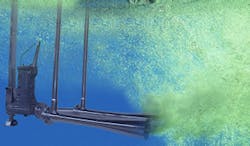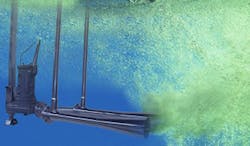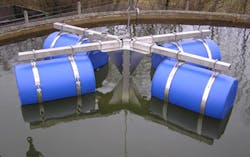Aeration Problem? The Proper Mixer May Be All You Need
By Soren Rasmussen
Looks can be deceiving. At first glance, there can often appear what seems to be plenty of aeration activity in an effluent tank, but in reality, there is sometimes very little happening that is beneficial to the process.
Outdated equipment such as old surface aerators can busily create ‘a dancing tank' with lots of noise and bubbles, but this type of equipment is only capable of aerating the top part of the tank -- often as little as 20 percent of the total volume. So despite all the bubbling commotion, solids can and do settle out, resulting in unpleasant septic solids at the bottom of the tank.
When a discharge permit violation or an odor problem has been identified, the dancing-effluent-tank scenario seems to become even more frenetic. The tendency is to expend more power, which places added strain on the utility bill. Further, this practice is an unnecessary waste of energy and still results in poor-settling sludge.
A supposed aeration problem is often nothing of the sort; it is simply the need for an efficient and appropriate mixer. When aeration equipment was first installed in wastewater tanks many years ago, the original design may have achieved the required balance, but manufacturing requirements, new process technology and legislation have inevitably seen conditions change.
We are often called in to address wastewater problems caused by changes to production lines that have increased the biological load. There can also be issues prompted by rises in temperature, seasonal loads, in-factory waste minimization, or improvements and additions to upstream processes. Because aeration and mixing are vital to a healthy treatment process, it is best to routinely review the wastewater element as part of the whole manufacturing process so that a fully-mixed and properly-aerated tank is consistently achieved.
Just as problematic as over-aeration is under-aeration. Low dissolved oxygen (DO) in the tank and reduced biological activity will produce bulking sludge, unpleasant odors and ultimately failure to meet discharge permits. Under-aeration can also be caused by changes to conditions such as COD/ammonia loading and increases in the tank's temperature.
Working with Roquette America, a producer of starch products, syrups and polyols (sugar alcohols), we saw how the use of a diffused air system (fed by large blowers) meant constant cleaning and replacing of diffuser membranes. This included the substantial expense of hiring divers to enter the tanks and perform maintenance so as to not interrupt the 24/7 operation. Installing a self-aspirating aeration system that incorporates heavy-duty chopper pumps has resulted in a completely clog-free operation and a homogenous mixture for higher air-to-water transfer. Energy bills alone at Roquette have been reduced by 30 percent, and constant laborious maintenance has now become a simple, economic, once-a-year requirement.
As with Roquette, the overall focus should be optimum configuration of aerators and mixers for maximum treatment at minimum maintenance and power use. Hydraulic mixing of the basin will depend on several factors, not just the tank's geometry, dimensions and layout. One needs to look at the actual hydraulic mixing power provided by aerators, as well as issues such as floor-sweeping velocities greater than 0.8 ft/sec, which are required to prevent the settling out of solids that lead to anoxic or anaerobic pockets.
Some facilities can experience serious discharge permit violations or odor problems but have no monitoring in place to inform them of what is happening in the aeration basin. Those who expend more power to help resolve what they perceive solely as an ‘aeration problem' should consider the fact that low-speed, energy-efficient propeller mixers can solve their problem at a fraction of the power cost. Those with an aeration/mixing requirement should not be deterred by potential downtime because a mixer installation can often be performed even when the tank is full.
Without proper mixing, areas of aeration tanks could be suffering from anaerobic conditions. But unless there is a noticeable odor problem, operators can be completely unaware that this vital part of their treatment process isn't working as it should be. This could result in indefinite, unnecessarily high expenses or failure to meet discharge permits. Further, aerobic conditions will not be achieved throughout the process vessel, resulting in poor treatment. This is particularly true for any site that is contending with a high-strength effluent. Therefore, any facility striving to achieve as much treatment as possible on-site is encouraged to consider aeration and mixing to reduce total operation costs.
About the Author: Based in Cary, N.C., Soren Rasmussen is the director of Landia Inc., the U.S. subsidiary of Danish company Landia A/S, established in 1933.


